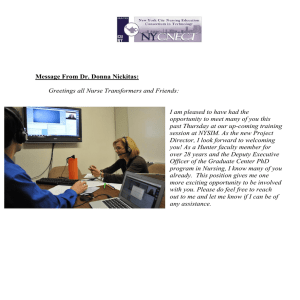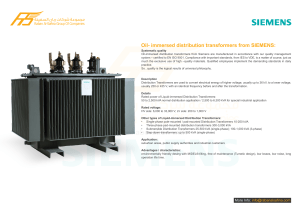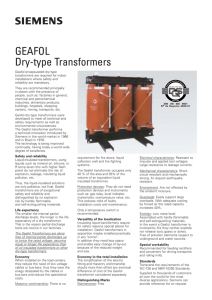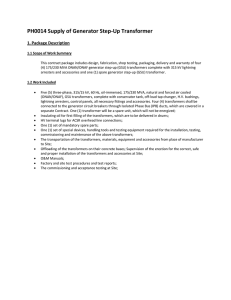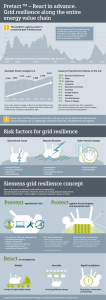transformers - University of Cincinnati
advertisement
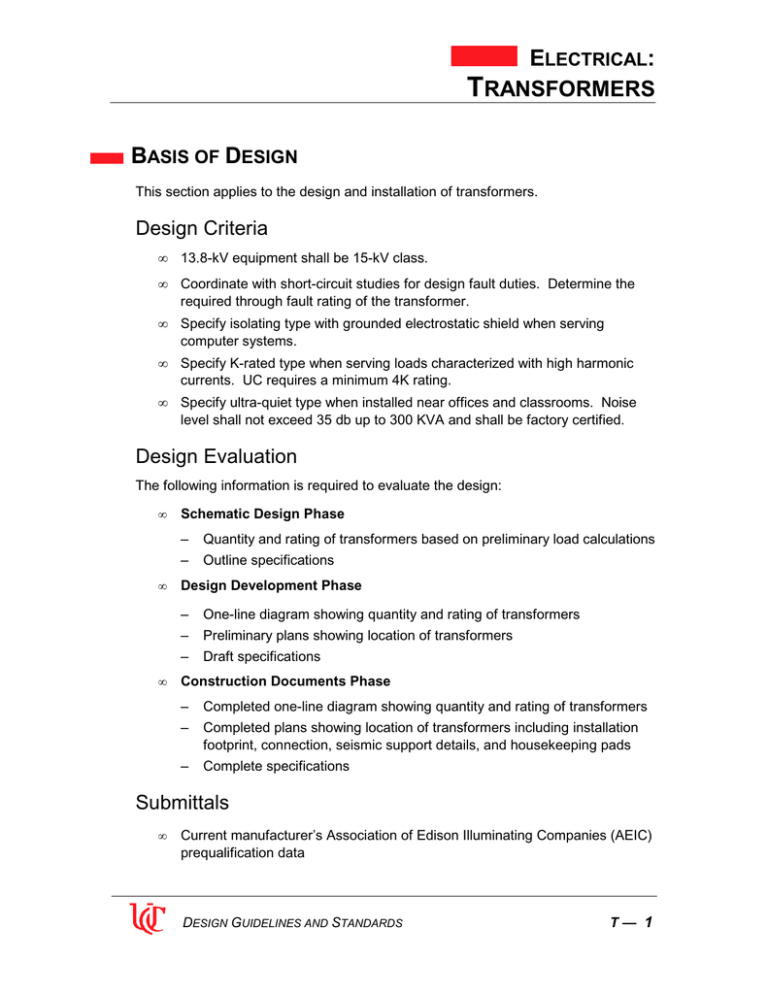
ELECTRICAL: TRANSFORMERS BASIS OF DESIGN This section applies to the design and installation of transformers. Design Criteria • 13.8-kV equipment shall be 15-kV class. • Coordinate with short-circuit studies for design fault duties. Determine the required through fault rating of the transformer. • Specify isolating type with grounded electrostatic shield when serving computer systems. • Specify K-rated type when serving loads characterized with high harmonic currents. UC requires a minimum 4K rating. • Specify ultra-quiet type when installed near offices and classrooms. Noise level shall not exceed 35 db up to 300 KVA and shall be factory certified. Design Evaluation The following information is required to evaluate the design: • • • Schematic Design Phase – Quantity and rating of transformers based on preliminary load calculations – Outline specifications Design Development Phase – One-line diagram showing quantity and rating of transformers – Preliminary plans showing location of transformers – Draft specifications Construction Documents Phase – Completed one-line diagram showing quantity and rating of transformers – Completed plans showing location of transformers including installation footprint, connection, seismic support details, and housekeeping pads – Complete specifications Submittals • Current manufacturer’s Association of Edison Illuminating Companies (AEIC) prequalification data DESIGN GUIDELINES AND STANDARDS T— 1 ELECTRICAL: Transformers • November 2004 Shop drawings including: – Complete description of products to be supplied, product data, dimensions, specifications, connection diagrams, and installation instructions – Detailed selection data for vibration isolator supporting equipment, equipment identification mark, isolator type, and actual load Products, Materials, and Equipment Unless otherwise specified, transformers shall meet the sound levels of the National Electrical Manufacturers Association (NEMA), the American National Standards Institute (ANSI), and/or the Institute of Electrical and Electronics Engineers (IEEE), whichever is most conservative. Supply certified tests upon request of University of Cincinnati Construction Management (CM). ► Note: The above requirement may necessitate architectural solutions. Dry-Type Transformers Transformers shall be of fire-resistant, air-insulated, dry-type construction, cooled by the circulation of air through the windings. Transformers shall be 150 degree C; class H, 220-degree insulation, indoor-ventilated dry type, vacuum pressure impregnated (VPI). The entire core and coil assembly shall be VPI with a high-temperature thermo setting polyester varnish. The total VPI process shall apply a one-cycle shield of resin to the coils and bus, core, and support structure. The VPI process shall effectively encapsulate the entire core and coil assembly, resulting in a transformer that is virtually impermeable by moisture, dust, dirt, salt air, and other industrial contaminants. The electrical insulation system shall utilize Class H material in a fully rated 220-degree C system. Base transformer design temperature rate of rise shall be on a 30-degree C average ambient over a 24-hour period with a maximum of 40 degrees C. Solid insulation in the transformer shall consist of inorganic materials such as porcelain, glass fiber, and electrical-grade glass polyester on Nomex. All insulating materials must be rated for continuous 220 degree C duty. The insulation between the high and low voltage coils shall be more than sufficient for the voltage stress without need for a varnish. Transformers shall be of the highest quality, manufactured by a firm that has manufactured such apparatus for at least 25 years. Transformers shall have minimum 98 percent efficiency. DESIGN GUIDELINES AND STANDARDS T — 2 ELECTRICAL: Transformers November 2004 Transformers will have high-voltage (primary) terminal markings: 1. “H1" to "A" Phase 2. "H2" to "C" Phase 3. "H3" to "B" Phase Low-voltage switchgear normally connected to building power service transformers will be constructed in accordance with industry standards. Buses will be identified "1," "2," "3," and "N." Transformers will have low-voltage (secondary) terminal markings "X1," "X2," "X3," and "X0" from left to right or top to bottom when facing the low-voltage terminals. The switchgear shall be as follows: 1. "X1" to "1" (BUS) 2. "X2" to "2" (BUS) 3. "X3" to "3" (BUS) ► Note: The transformer connections as indicated above will result in a rotation sequence at the low voltage switchgear of "1," "2," "3". All transformers shall be provided with American Standard connection, 30-degree negative angular displacement. Transformer impedance should be about 5.75 percent (7 percent for three-transformer networks). For two-transformer networks, special transformer impedance must be determined so that voltage regulation issues are resolved. Confer with Construction Management for these applications. Transformers shall be provided with the following: • Diagrammatic nameplate listing all detailed information as required by NEMA standards. • Four 2½ percent, full-capacity taps, two above and two below rated voltage. • Lifting lugs. • Base suitable for skidding in all directions. Transformer case shall be supplied in a knockdown design. • Windings, which shall be copper. • A fully insulated secondary neutral bushing (externally groundable) to permit the use of a neutral conductor or current transformer or sensing of ground fault currents. • Terminal markings on the transformer terminals. These markings shall clearly identify each terminal when doors or covers are opened. DESIGN GUIDELINES AND STANDARDS T — 3 ELECTRICAL: Transformers November 2004 • Electrical connections between the transformer and the switchgear (these shall be provided by the switchgear manufacturer). • Air-filled primary terminal chamber adequately sized for stress cone termination of three or six single conductors, as indicated. • For transformers serving the "normal" loads: Automatic temperature-controlled fans. These forced-air (FA) units shall contain all necessary components and wiring, including fans, for increasing the KVA ratings by 33 percent at 150 degrees C. The FA package shall include an electronic temperature monitor and fan control unit with the following features: – Digital readout: Green = power on; yellow = fan on; red = high-temperature indicating lights – Audible high-temperature alarm with alarm silence pushbutton – Maximum temperature memory with read and reset switch – Auto/manual fan control switch – System test switch – Temperature sensing in all three low voltage coils Auxiliary alarm contact and means for remote control and temperature monitoring shall be provided. Control power shall be provided from a control power transformer in the secondary switchgear. • For emergency unit substation transformers: pre-wiring for future fan cooling, including resistance temperature detector (RTD) or thermocouples embedded in the windings for temperature control (same as FA package described above, but without fans). • Continuous ¼-inch by 2-inch ground bus for connection to the adjacent compartment's switchgear. Transformers shall be designed to meet the sound level standards for dry-type transformers as defined in NEMA TR1. The following factory tests shall be made on all transformers, although not necessarily in the order listed. All tests shall be in accordance with the latest revision of ANSI Test Code C57.12.91 and NEMA TR1, IEEE 262A-1974: • Resistance measurements of all windings on the rated voltage connection of each unit and at the tap extremes of one unit only of a given rating on this indoor or outdoor installation. • Ratio tests on the rated voltage connection and on all tap connections. • Polarity and phase-relation tests on the rated voltage connections. • No-load loss at rated voltage on the rated voltage connection. DESIGN GUIDELINES AND STANDARDS T — 4 ELECTRICAL: Transformers November 2004 • Exciting current at rated voltage on the rated voltage connection. • Impedance and load loss at rated current on the rated voltage connection of each unit and on the tap extremes of one unit only of a given rating on this project. • Temperature test(s), to be made on one unit only of a project covering one or more units of a given KVA rating. Tests shall not be required when there is an available record of a temperature test on an essentially duplicate unit. When a transformer is supplied with auxiliary cooling equipment to provide more than one KVA rating, temperature tests as listed above shall be made on the lowest KVA AA rating [and the highest KVA FA rating]. • Applied potential test. • Induced potential tests. Transformers shall include a steel panel enclosure with louvered openings to guard against insertion of foreign objects. Ventilated dry-type transformers shall comply with ANSI C57.12.51. Liquid-Filled Transformers The following requirements shall apply to liquid-filled transformers: • Liquid-filled transformers shall be for outdoor use only. • Liquid-filled padmount transformers shall comply with ANSI C57.12.27. • Only dead-front design shall be used. • Transformers may be integral with primary switching, fusing, and separable connection compartment. • Connections shall be via bushing wells for Elastimold or Colt Industries removable studs. • Removable bushings shall be included. • Load break parking stands shall be included. • Protection shall be via bayonet fuse. No isolation links are allowed. Vibration Isolation Mounting type, unit DNP (double neoprene pad): Neoprene pad isolators shall be formed by two layers of ¼-inch to 5/16-inch-thick ribbed or waffled neoprene, separated by a stainless steel or aluminum plate. These layers shall be permanently adhered together. Neoprene shall be 40 to 50 durometer. The pads shall be sized so that they will be loaded within the manufacturer's recommended range. DESIGN GUIDELINES AND STANDARDS T — 5 ELECTRICAL: Transformers November 2004 A steel top plate equal to the size of the pad shall be provided to transfer the weight of the supported unit to the pads. Installation, Fabrication, and Construction Units shall be anchored to their pads as required to meet seismic zone requirements. Initially connect transformers at “normal tap.” After the facility is completely energized, measure the primary and secondary voltages at all transformers and the service switchboard. Forward a list to the Engineer for evaluation. Reconnect and adjust taps as directed. All costs associated with this work are to be included in the base bid. END DESIGN GUIDELINES AND STANDARDS T — 6
